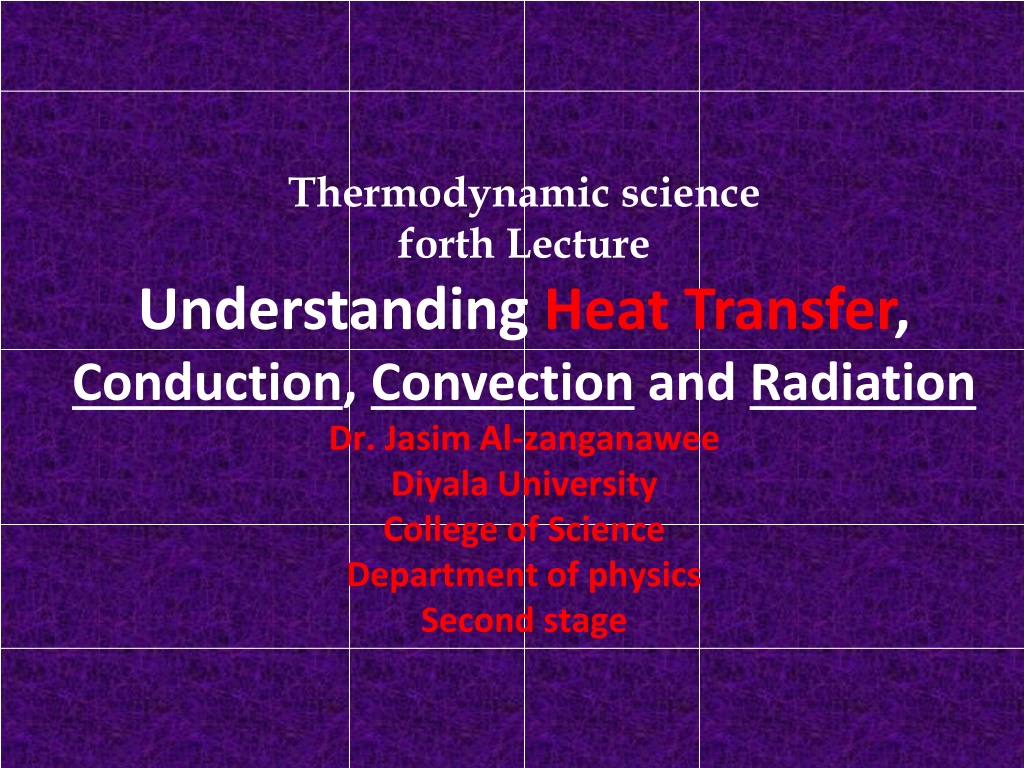Understanding Heat Transfer in Thermodynamics Lecture
This thermodynamics lecture covers essential topics such as heat transfer, conduction, convection, and radiation. Dr. Jasim Al-zanganawee from Diyala University explains Thermodynamic Processes, Internal Energy, Properties of a System, and Thermodynamic Cycles. Students will learn about extensive and intensive properties of a system, states of a thermodynamic system, and various types of processes including isothermal, isobaric, constant-volume, and adiabatic processes. Additionally, the lecture delves into the concept of Internal Energy, which encompasses the microscopic components of a system such as kinetic and potential energy.
Download Presentation

Please find below an Image/Link to download the presentation.
The content on the website is provided AS IS for your information and personal use only. It may not be sold, licensed, or shared on other websites without obtaining consent from the author. Download presentation by click this link. If you encounter any issues during the download, it is possible that the publisher has removed the file from their server.
E N D
Presentation Transcript
Thermodynamic science forth Lecture Understanding Heat Transfer, Conduction, Convection and Radiation Dr. Jasim Al-zanganawee Diyala University College of Science Department of physics Second stage
Objectives Objectives Students will be able to identify and know Thermodynamic Processes. Students will be able to Know and understand the Internal energy. Students will be able to Know types of Internal energy Students will be able to Know the relationship between the Internal energy and Temperature Students will be able to understand how can Work change the Internal energy of the System
Property, State and Process of the system Property macroscopic characteristic of a system Page 2 : Extensive properties The value for the overall system is the sum of the values for its parts (mass, volume, energy) - Intensive properties The values are not additive, may vary from one place to the other at any time (pressure, temperature, specific volume) . ( Extensive Properties ) Intensive ( Properties ) . State a condition of a system, described by the properties. usually a snapshot in time x(t)=(P,T) . x(t)=(P,T) -
Thermodynamic Processes States of a thermodynamic system can be changed by interacting with its surrounding through work and heat. When this change occurs in a system, it is said that the system is undergoing a process. . A thermodynamic cycle is a sequence of different processes that begins and ends at the same thermodynamic state. Some sample processes: Isothermal process: temperature is constant T=C. Isobaric process: pressure is constant, P=C Constant-volume process, v=C Adiabatic process: no heat transfer, Q=0 ( ( Adiabatic Process ) . ( Isothermal Process ) ( Isobaric Process ) ( Isochoric Process ) . ) . . Page 3
P Isobaric process P = constant V Isovolumetric process V = constant W = 0 P V Isothermal process T = constant U = 0 (ideal gas) P V Adiabatic process Q = 0 P V Page 4
Internal Energy Page 5 All systems have internal energy-- U . Internal Energy, U, is the energy associated with the microscopic componentsof the system which Includes kinetic and potential energy associated with the random translational, rotational and vibrational motion of the atoms or molecules. Also includes any potential energy bonding the particles together The internal energy U is the sum of the energy of all the molecules in the system U KE PE = + interaction between atoms & molecules Random chaotic motion Box containing N molecules all moving around randomly Thermal Energy= Internal Energy Thermal Energy= very broad term, no specific meaning
Internal Energy U cannot be measured directly, but is there a parameter that represents U and can be measured? Page 6 Value of U not important, U during a thermal process is what matters: U U = 2 = U U final U 1 initial ) ( U U is a state function --- depends uniquely on the state of the system in terms of p, V, T etc. (e.g. For a classical ideal gas, U = NkT ) The internal energy U of an ideal gas depends only on its temperature, not on its pressure or volume U= U(T)
Page 7 INTERNAL ENERGY - it is composed of the following types of energies: 1. Sensible energy - internal energy associated with random, chaotic kinetic energies (molecular translation, rotation, and vibration; electron translation and spin; and nuclear spin) of the molecules. 2. Latent energy - the internal energy associated with the phase of a system. 3. Chemical energy - the internal energy associated with the atomic bonds in a molecule. 4. Nuclear energy the very large amount of energy associated with the strong bonds within the nucleus of the atom itself. . :
Internal energy and temperature in a gas the molecules have energy because they are moving. the sum of all the energies of all the molecules is the system s internal energy the temperature of the system is a measure of the average kinetic energy of the atoms, Temperature Average Kinetic Energy Page 8
Temperature and Internal Energy Temperature, T, measures the average kinetic energy (KE) of the molecules The internal energy, U, is the total energy of all of the molecules T1 = T2 = T3 50 C U3 > U2 > U1 50 C 50 C 1 2 3 Page 9
Work can change internal energy When one object is rubbed against another, work is done and heat is produced When a gas is compressed its internal energy is increased; when it expands, its internal energy decreases . The internal energy of a system can change if work is done on the system or heat is transferred to it. (1st Law of Thermo.) ). ( . Page 10


























